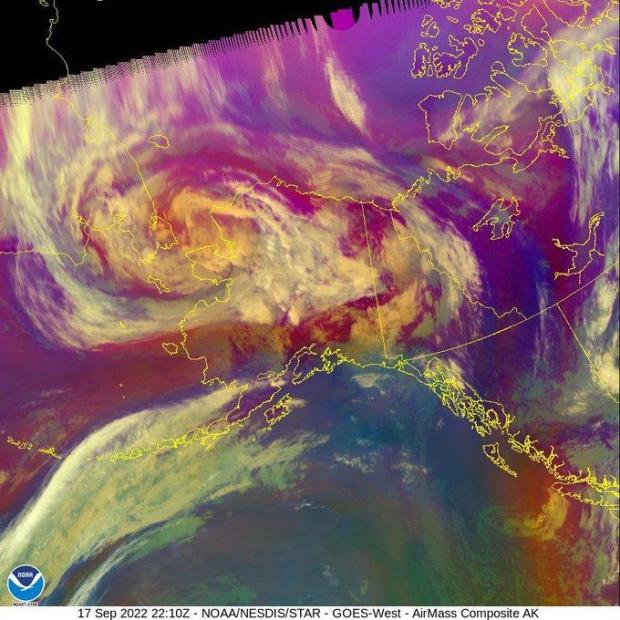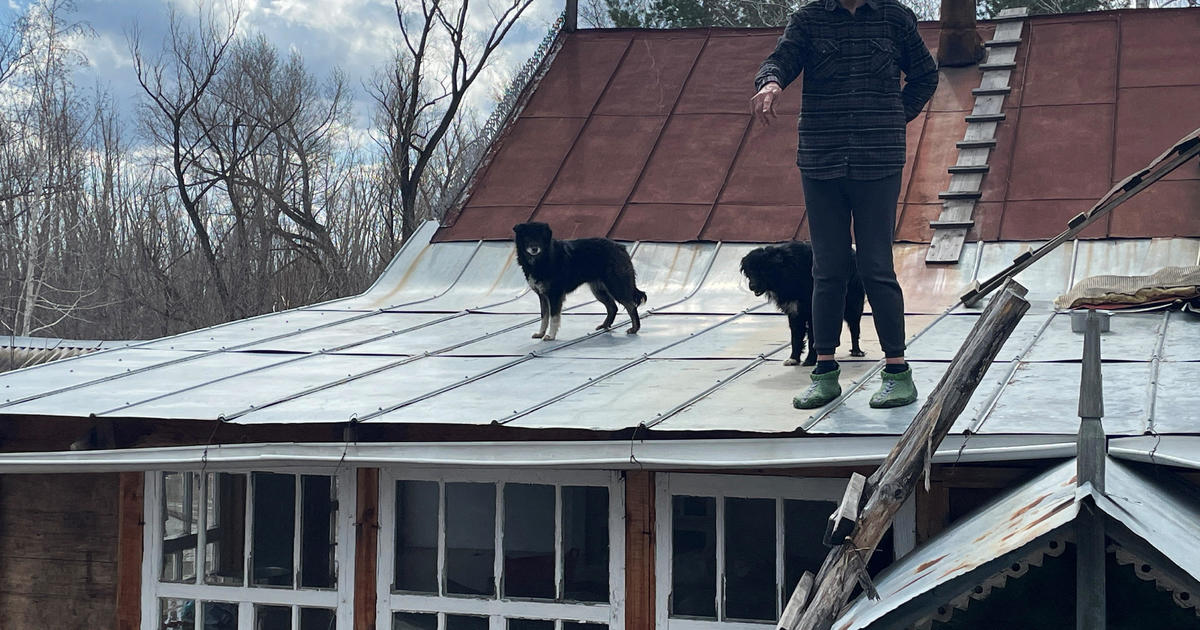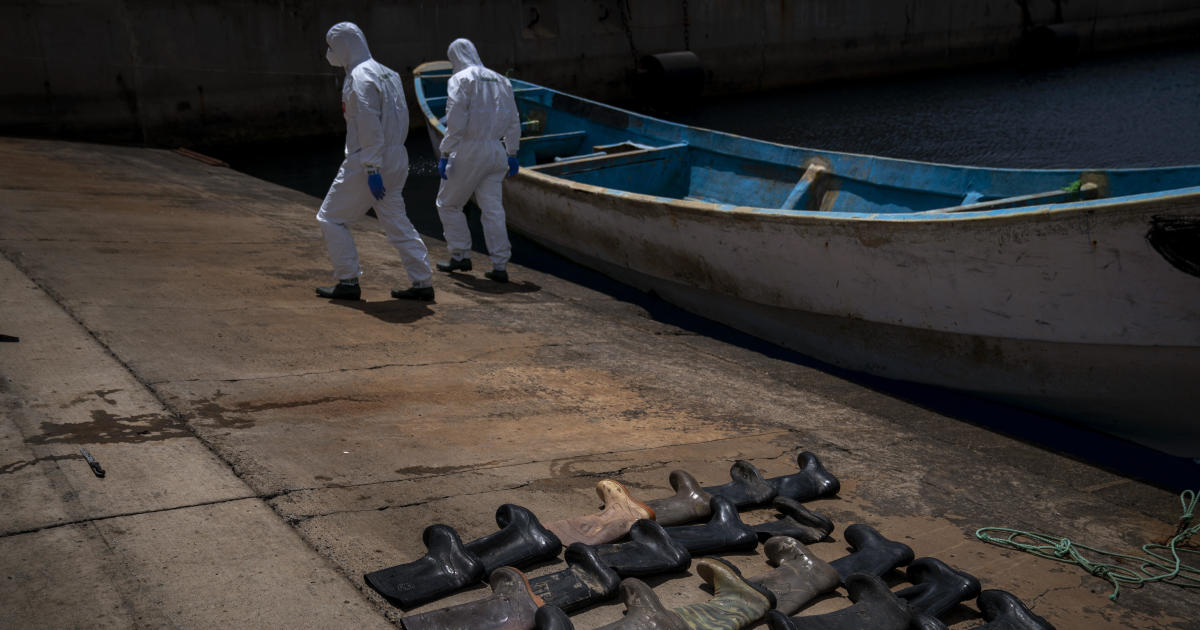"We've got a house ... floating upstream": Massive storm batters Alaska's west coast
Floodwaters were receding in parts of western Alaska battered by the worst storm in a half century, leaving behind debris flung by powerful Bering Sea waves into beaches and seaside communities.
The storm, the remnant of Typhoon Merbok, was weakening Sunday as it moved north from the Bering Strait into the Chukchi Sea on Alaska's northwest coast, where it still threatens smaller communities, said National Weather Service meteorologist Kaitlyn Lardeo.
"This guy is going to hang out in the Chukchi Sea for the next few days and just rapidly weaken because it's so stationary," she said.
Several communities reported homes were knocked off their foundations by the force of the incoming water, often propelled by winds gusting near 70 miles per hour. One house in Nome floated down a river until it got caught under a bridge.
It was a massive storm system — big enough to cover the mainland U.S. from the Pacific Ocean to Nebraska and from Canada to Texas. It influenced weather systems as far away as California, where a rare late-summer storm dropped rain on the northern part of the state, offering a measure of relief to wildfire crews but also complicating fire suppression efforts because of mud and loosened earth.
There have been no reports of injuries, deaths or missing people in Alaska, the governor said during a Sunday news conference. A child reported missing Saturday was later found, he said. Officials had warned some places could see their worst flooding in 50 years, and that the high waters could take up to 14 hours to recede.
Gov. Mike Dunleavy issued a disaster declaration during the day Saturday.
Dunleavy said Sunday roads are damaged and state officials are assessing potential damage to seawalls, water and sewage systems, airports, and ports. He identified five communities — Hooper Bay, Scammon Bay, Golovin, Newtok and Nome — as being greatly impacted by a combination of high water, flooding, erosion and electrical issues in either the towns or their airports.
Emergency management and American Red Cross personnel will deploy to those communities as soon as Monday, while Alaska National Guard members will be sent to Nome, Bethel and Hooper Bay to assist residents. Red Cross volunteers from the Lower 48 will also conduct needs assessments for food, water and shelter in other flooded villages.
Many homes were flooded and about 450 residents on the western coast sought refuge in shelters, with more than half of them at a school in Hooper Bay, where they ate processed moose donated by village residents. Others rode out the storm on higher ground outside their communities.
Federal Emergency Management Agency representatives were already in Alaska before the storm.
Among the hardest hit communities was Golovin, a village of 170 or so residents who mostly sought shelter at a school or in three buildings on a hillside. Winds in the village gusted over 60 mph and the water rose 11 feet above the normal high tide line and was expected to rise another 2 feet Saturday before cresting.
"Most of the lower part of the community is all flooded with structures and buildings inundated," said Ed Plumb, a meteorologist with the National Weather Service in Fairbanks.
Clarabelle Lewis, the facility manager for the tribal government, the Chinik Eskimo Community, was among those who sought refuge on the hill overlooking Golovin. She and others were riding out the storm in the tribal office after securing items at their homes from the high winds and helping neighbors do the same.
"The winds were howling; it was noisy," she said.
Paul Kosto, the logistic section chief for the Unified Command in Nome, Alaska, told CBS affiliate KEYS in Anchorage that the city is reporting road damages, flooding, and houses were moved off of their foundation and are afloat.
"We've got a house in the Snake River that is floating upstream, if you can believe that, because the winds are strong enough and pushed it up towards a bridge," Kosto said.
Kosto said for the last 14 to 18 hours they had been experiencing high winds of over 70 mph.
"We have definitely seen some hurricane force winds in the last day," Kosto said. Nome also has lots of rain and high surf on the coastline.
Tidal wave heights were reached at Nome early on Saturday evening, so the high water focus shifts northward to the north side of the Seward Peninsula and along the northwest coast of the state from Kotzebue to Point Hope and up to Wainwright during the first part of Sunday, according to KYES.
Most communities experienced wind gusts ranging from 41 mph to 67 mph, but Cape Romanzof had peak winds of 91 mph, the weather service said.
Lewis has never experienced a storm like this in 20 years living in Golovin.
"We've had flooding in the past a few times, but it was never this severe," she said. "We've never had homes moved from their foundations."
There were also reports of flooding in Hooper Bay, St. Michael's, Unalakleet and Shaktoolik, where waves crashed over the berm in front of the community, Plumb said.
In Hooper Bay, more than 250 people took shelter inside the school, Bethel public radio station KYUK reported. The village is one of the largest along the coast with nearly 1,400 residents.
The school's vice principal, Brittany Taraba, said three homes were knocked off their foundations and large parts of the village were flooded.
Residents are supporting each other, including donating recently caught and processed moose to feed those sheltering at the school.
"It's really amazing to watch this community," Taraba told KYUK.
Plumb said the storm would track through the Bering Strait on Saturday and then head into the Chukchi Sea.
"And then it's going to kind of park and weaken just west of Point Hope," he said of the community on Alaska's northwest coast.
He said there would be high water in the vicinity of the northern Bering Sea through Saturday night before levels start to subside through Sunday. Rising water levels farther north, in the Chukchi Sea and Kotzebue Sound areas, were expected into Sunday.
An earthquake, meanwhile, shook Fairbanks, Alaska's largest city, at 5:16 p.m. local time Sunday, according to the U.S. Geological Survey.
The epicenter was near the Minto Flats Fault Zone, the National Weather Service reported. According to the USGS, the epicenter was about 45 miles west of Fairbanks.
"Shook our building pretty good," the NWS tweeted.






